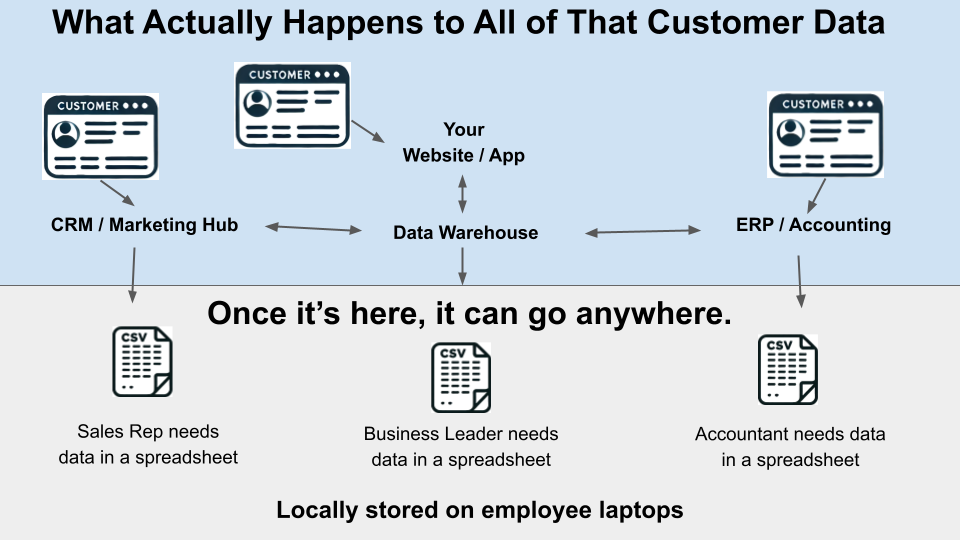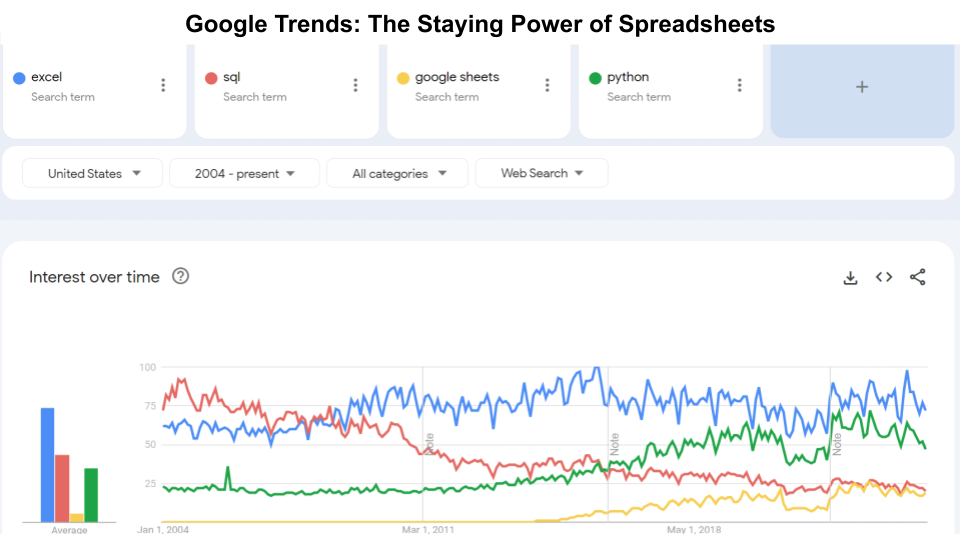We’ve all done it. Most customer software has it. And it just may be the most widespread security vulnerability in corporate America - Export to CSV.
Companies spend billions of dollars to keep their data safe, secure, and organized. The reality is, it’s kind of a mess at most companies. And sensitive data is routinely sitting in Excel spreadsheets or downloaded as a CSV onto employees’ laptops as part of their normal work. Why? Because at the end of the day, the spreadsheet is still king. 
The Rise of the Data Industrial Complex
The last 10 years has seen explosive growth in customer data tracking and storage. Coupled with the proliferation of cloud service providers for everything from CRMs and marketing hubs to accounting software and ERPs, there’s more business critical data in more places than ever before. This presents not only a security risk, but also a disjointed and fragmented data environment for many companies. There’s an elusive search for alignment around the “source of truth”.
Companies spend millions of dollars to get their data into cloud data warehouses like Snowflake, Databricks, and Redshift. They hire teams of data engineers to architect and manage the data. They buy expensive, complex business intelligence software like PowerBI and Tableau to slice, dice, and visualize the data. And they spend big money to keep it secure.
But there’s one big problem...
Everyone gets a CSV!
These data warehouses store all the data, but they don’t necessarily contain all the data. Afterall, it still lives in all of its original sources - Salesforce, Hubspot, Mailchimp, Braze, Quickbooks, NetSuite, and hundreds more. There's a reason why all this software exists. It’s where most business users do their work and the data is required to be there.
The other place most business users and nearly everyone at some point do their work is in a spreadsheet. Despite all the fancy AI and big data BI tools out there, spreadsheets are still king. The big walls around the data warehouse (and lack of alignment/confidence in the “source of truth”) mean that people will get their data where it’s easiest.
- When a sales rep needs data in a spreadsheet what do they do? Export to CSV
- When finance needs to troubleshoot a discrepancy, what do they do? Export to CSV
- When an email marketer needs to clean up an email list, what do they do? Export to CSV
This is just day-to-day CSVing. There’s also the possibility of malicious exporting of data by disgruntled employees or employees on their way out the door.
Once the data is in a CSV on their computer, it can easily go anywhere - in the cloud or right out the door.
The Inside Job - CSVs walking out of your data warehouse
When an entire company’s dataset is stored in the data warehouse and complex BI tools are the only way to access it, companies have created real barriers for the average business user or analyst to do their job. In some cases, the barriers are intentional to ensure data governance and security, but it’s also inefficient and expensive. Employees now have to make requests to the data team just to get the data they need to do their jobs. The reality is, they just need data in a spreadsheet. So alas, the data folks run a SQL query or create a dashboard and their business partner hits “export to CSV” and a CSV full of confidential data walks right out the door. Even technical folks end up in a spreadsheet at some point.
So what’s the solution? Time for the Row Zero pitch
Should everyone just stop using spreadsheets? That’s not going to happen. 2 billion people use spreadsheets. Spreadsheets are the original BI tool and they’re still on top. 
Some companies are taking big steps to prevent data leakage in their organization and improve spreadsheet governance and we’re working with several of them at Row Zero. They set data export permissions, not only in their data warehouse, but across their entire software stack. And rather than playing CSV whack-a-mole, they’re leaning into spreadsheets.
That’s where Row Zero fills a need. Row Zero is the best spreadsheet for big data. It connects directly to your data warehouse and our spreadsheets can pull entire database tables (1+ billion rows) into a spreadsheet and business teams can pivot, graph, XLOOKUP, and SUMIF to their heart's content. Row Zero runs in the cloud and can turn off data export options, giving business teams the spreadsheet they want without the security risk of CSV exports.
Not only can Row Zero play a critical role in keeping your data secure and in the cloud, it also lets your company unlock the power of big data in a spreadsheet they already know how to use.
Ready to give it a try?
You can try Row Zero for free or schedule a demo to see why Row Zero is the best spreadsheet for big data.